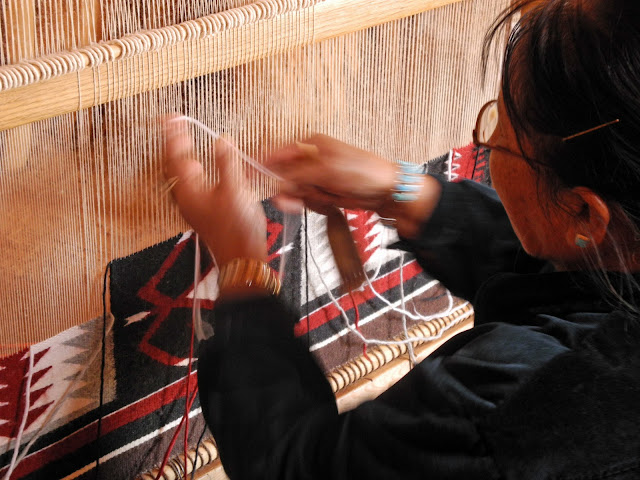A Navajo Poem (First Stanza)
Today I will walk out, today everything evil will leave me,
I will be as I was before, I will have a cool breeze over my body.
I will have a light body, I will be happy forever,
nothing will hinder me.
I walk with beauty before me. I walk with beauty behind me.
I walk with beauty below me. I walk with beauty above me.
I walk with beauty around me. My words will be beautiful.
I will be as I was before, I will have a cool breeze over my body.
I will have a light body, I will be happy forever,
nothing will hinder me.
I walk with beauty before me. I walk with beauty behind me.
I walk with beauty below me. I walk with beauty above me.
I walk with beauty around me. My words will be beautiful.
She sits on the floor of her octagonal, wooden hogan for hours at a time, weaving a rug in the traditional Navajo method. It will take 2 to 3 months to weave an average 4’ x 6’ rug, maybe 5 to 6 months for an exceptionally complex weave. The pattern seen here has taken 6 weeks to create. There are no short cuts in the weaving process. They are all hand woven on a traditional upright loom. As she works, the completed portion is rolled to the bottom of the loom.
In Navajo weaving, the warp is one continuous length of yarn, not extending beyond the weaving as fringe. A traditional Navajo geometric pattern is determined by the weaver before the rug has begun, and every nuance of the design is recalled from memory. One way to tell the quality of the rug is to count and compare the geometrics at the beginning and the end to see if they are the same.
Navajo textiles were originally utilitarian blankets for use as cloaks, dresses, saddle blankets and similar purposes. Toward the end of the 19th century, weavers began to make rugs for tourism and export. The Navajo did not produce rugs until export markets expanded at the end of the 19th century, and their textiles served no specific religious or ceremonial function. Today, more than 300,000 Navajo people live in the 16 million acre Navajo Nation, about the size of West Virginia
The Navajos believe that part of their spirit or soul gets trapped in the rug as it is woven on the loom. They purposely leave a small piece of yarn, called the “spirit string,” sticking out slightly from the surface of the rug. This will allow their spirit or soul a way to get out of the rug. They also believe that only God is perfect; therefore, they will make sure their woven creation has a small, hard-to-find imperfection. On a Navajo rug, it’s the loose piece of yarn.
Handmade Navajo rugs are truly works of art. Each rug is a one-of-a-kind item taking many months to create, and true in every sense of the word “handmade.”



Dr. Share - simply gorgeous - I remember spending time in Bryce Canyon and the Grand Canyon - years back - it truly is a marvel to behold - I can't wait to bring my kids back - we're trying for this summer before Tyler gets too deep into his med studies at BU - it was great to see you the other day - Keep up the great blog - Michael Kalajian
ReplyDeleteJack: This is amazing! you could be teaching a dynamite course with your knowledge and your curiosity and your eye.
ReplyDeletethanks,
Mikki